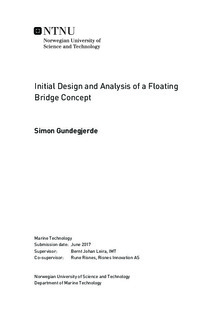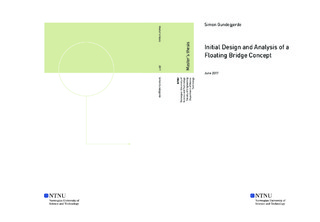| dc.description.abstract | The Norwegian government has an ambitious goal of connecting the Western coast of Norway with a ferry free road stretching from Kristiansand in the south to Trondheim in the north. This road has eight fjords which has to be crossed with ferries today. In order to reach their goal, it has been initiated several projects studying the possibility of crossing some of the widest and deepest fjords with floating bridges.
One of the biggest challenges, in addition to the technical, lies in the economical aspect of the project. Over the last three years, the estimated cost for the project Coastal Highway Route E39 has increased from 150 to 340 billion NOK. The XBridge concept by Rune Risnes tries to utilize well known solutions in order to reduce the cost.
This thesis will describe the concept behind the X-Bridge, the initial design process and how the different dimensions are decided. The focus will be on clarifying the choices made, how the model is built and the overall behaviour with wave loadings.
The hydrodynamic analysis is performed in Wadam using the software HydroD. The bridge model is created as a coupled Simo/Riflex model using the software Sima. The model is analysed in static conditions and with regular dynamic waves. In addition, an eigenvalue analysis is performed.
Results show that the suggested bridge girder is too weak for the concept due to large static bending moments and shear forces. The wall thickness of the girder should be increased. Static stresses dominate the results due to the long spans. The model response behaves linearly, making it possible to estimate the response for several wave heights with the same period.
It is not possible to see any effect of the cables connecting the two arches in the results. Further work should focus on the unique features of the concept. This study has shown that including too many aspects in the model makes it more difficult to identify the special properties of the concept. | |

